Top News
September 15, 2012 Ryukyu Shimpo
On September 14, the Okinawa Prefectural Government (OPG) Department of Culture, Tourism and Sports announced that the number of tourists who visited Okinawa this August was 607200 people. This represents a 2.4 percent increase over the same month last year, and this is the seventh month in a row in which last year’s figures have been exceeded. The number of inbound Japanese tourists rose 0.4 percent to 562100, with foreign tourists jumping 34.2 percent to 45100 people in August, the largest number ever. A spokesman for the OPG said, “We had typhoons at the beginning and the end of August, but travel to Okinawa was stable.”
Because of the typhoons, only one cruise ship visited Okinawa during this period, the liner Voyager of the Seas from Shanghai. However, compared with last year, transport options by air and sea have been expanded and the number of tourists from abroad has increased.
If we look at the tourists by country and region, those from Taiwan increased 21 percent to 17300 people (38.4 percent of the total). Tourists from China increased 189.5 percent to 11000 people (24.4 percent), those from Hong Kong fell 8.8 percent to 7300 people (16.2 percent), Korea increased 20 percent to 2400 people (5.3 percent), the United States increased 33.3 percent to 400 people (0.9 percent) and those from other countries increased 28.8 percent to 6700 people (14.9 percent).
The number of Japanese tourists visiting Okinawa has not risen greatly because the strong yen led to people going abroad and because of Typhoon Bolaven, which hit Okinawa in the weekend of summer vacation.
The number of tourists from the main islands of Japan is expected to gradually increase because low-cost carriers have started flights to Okinawa. At the same time, a staff member of the Prefectural Tourism Policy Division stated, “There is a negative reaction in China against Japan’s nationalization of the Senkaku Islands or Diaoyutais, so people may start to cancel their trips to Japan.”
(English translation by T&CT, Lima Tokumori and Mark Ealey)
Go to Japanese
September 18, 2012 Ryukyu Shimpo
In the morning of September 18, the Okinawa Prefectural Government (OPG) held a disaster response headquarters meeting to report on the damage caused by Typhoon Sanba. By 8:00am that day, it was known that damage to likes of sugar cane has been estimated at about 397 million yen. In addition to this, facilities for farming mozuku seaweed were also damaged. If we break down the amount of crop damage for each area, the northern region of Okinawa was about 200 million yen, the southern central region was 56 million yen, and the southern region was 140 million yen.
The OPG stated that the typhoon caused substantial damage to the fisheries industry such us to fishing-boats, floating bridges, aquaculture facilities and cold storage facilities.
Governor Hirokazu Nakaima decided to keep the disaster response headquarters team together for another week to further investigate the damage and to become involved in reconstruction assistance.
In all of Okinawa, there were 145 cases of flooding above floor level and 406 under floor level, especially in the northern regions such as Motobu. Flood damage in Naha is still being investigated, so it is possible that the figure for damage will increase. The numbers of people who opted to leave their homes were 544 people from 205 households, but this figure is expected to increase because the survey is not yet complete.
(English translation by T&CT, Lima Tokumori and Mark Ealey)
Go to Japanese
September 20, 2012 Ryukyu Shimpo
On September 19, at the Japanese Ministry of Foreign Affairs, a Japan-U.S. Joint Committee met to consider the deployment of the MV-22 Osprey to the U.S. Marine Corps Air Station Futenma. The two governments agreed on a set of measures designed to ensure the Osprey’s safe operation. The measures are centered on altitude restrictions for low-altitude flight training, and the period for flying with the aircraft’s twin rotors tilted forward being made as short as possible because the conversion maneuver for this is said to be unstable. At the Ministry, Defense Minister Satoshi Morimoto and Foreign Minister Koichiro Gemba held a joint press conference in which they declared that the Osprey is safe to fly in Japanese skies. They said that they have confirmed that the Osprey is safe and that it will be deployed to Futenma Air Station.
The U.S. Marines will begin test flights on September 21 at the Iwakuni Air Station in Yamaguchi Prefecture where 12 Ospreys remain on the ground after having been shipped from the United States. They plan to move the aircraft to Okinawa some time after September 28, hoping to start full operations of the aircraft at the Futenma Air Station in October.
At the press conference, Morimoto made it clear that the Japanese government decided to allow the U.S. military to begin operating the Osprey without local consent. He said, “The Japanese and U.S. governments agreed to fly the Osprey in Japanese skies once we have completed confirmation of the aircraft’s operational safety.” That same afternoon, Morimoto visited Yamaguchi Prefecture and asked Iwakuni Mayor Yoshihiko Fukuda to accept the newly devised measures, and to show understanding towards the start of test flights at Iwakuni. Morimoto said, “We have found no basis for thinking that the Osprey is any more dangerous than other aircraft. The government has decided to allow the U.S. military to start operating the aircraft on the premise that maximum care will be taken to ensure the safety of local residents regarding the aircraft’s flight safety.”
The measures do not include reviewing the traffic patterns of Futenma Air Station that Morimoto had vowed would be included. The Osprey will use the existing traffic patterns of fixed-wing aircraft and rotary-wing craft for routine take-offs and landings.
Based on the descent rate in the case of an engine shutdown the authorities at Futenma Air Station require that helicopters maintain an altitude of 305 meters when returning to base using autorotation. The Ministry of Defense insists that the Osprey can manage autorotation at that specified altitude. However, the Osprey lands at a descent rate of 1525 meters per minute, which is three times greater than that of existing helicopters. It is probable that the Osprey would not be able to take sufficient safety measures to avoid a possible crash.
Despite experts suggesting that the autorotation function of the Osprey is flawed, the ministry asserts that the aircraft will not be required to auto-rotate in most cases because both engines are unlikely to malfunction at the same time.
The Japanese and U.S. governments will consider conducting Osprey flight training outside of Okinawa.
(English translation by T&CT, Mark Ealey)
Go to Japanese
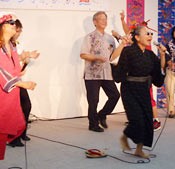
September 11, 2012 Ryukyu Shimpo
On September 3, the Hiyamikachi-machiguwa-kan was reopened in an upstairs clothing section of the Makishi Public Market in Naha. Almost every day the hall serves as a venue for free events for traditional arts, comedy, singing and dancing. On the first day, four members of the clothing section of the market performed the Okinawan dance kagiyadefu bushi to celebrate the opening. The Oba Rappers, who are based in the Sakae-machi Market also celebrated it with singing and dancing.
The project began last July in attempt to help revitalize the city center and by this March, it had already attracted 15000 people. It stopped its activities in March, but further subsidies allowed it to restart.
By offering public lectures the project aims to promote a sense of participation in social activities.
Naha Mayor Takeshi Onaga said, “This year’s program is very interesting. I hope that these events help people understand the appeal of the local community.”
Hiroko Yano, managing director of the Shopping District Promotion Association for the popular Naha tourist spot Heiwa Street, where the clothing section of the market is located, commented, “The various events will entertain a wide range of people. I also want to make the street enjoyable for locals.”
Takako Miyazato, who came to the Machiguwa-kan while out shopping, said, “It is fun to see the shows again. I’m looking forward to the events organized for this new program.”
For further details, refer to the official website: http://www.hiyamikachi.com/
(English translation by T&CT, Lima Tokumori and Mark Ealey)
Go to Japanese
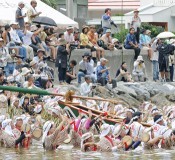
September 12, 2012 Ryukyu Shimpo
On September 11, the Unjami Festival was held in Shioya Bay and other areas of Ogimi. This event is designated as one of Japan’s significant intangible folk cultural assets. At shrine rooms in Tanna and Yafu, Okinawan shaman or kaminchu prayed for a good catch. This was followed by the Ugan Barley dragon boat race, which brought the festival to a climax. The Unjami Festival is held every year in the seventh month of the lunar calendar following the Bon season. It is said that the festival in Shioya dates back some 400 or 500 years to the time of the Ryukyu Kingdom.
At a shrine in Tanna, the kaminchu prayed for good health and safe sailing. They then served their family members some sacred sake and rice cakes. At a shrine in Yafu, kaminchu holding bows in their hands moved around a pole to pray for good harvest, chanting “Yonkoi, yonkoi.”
In the Ugan Barley dragon boat race, men rowed boats with kaminchu on board towards the coast of Shioya, shouting, “To-hya.” On the shore women waded into the water up to their hips, clapping their hands and beating drums as they greeted the boats.
(English translation by T&CT, Lima Tokumori and Mark Ealey)
Go to Japanese

Go To Video
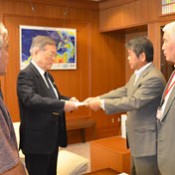
September 14, 2012 Ryukyu Shimpo
On September 13, a delegation from the Okinawan People’s Mass Rally held in Ginowan on September 9 demanded that the government cancel the deployment of the Osprey aircraft. The 44-member delegation met Defense Minister Satoshi Morimoto, Foreign Minister Koichiro Genba and Cabinet Secretary Osamu Fujimura. They handed the ministers a resolution demanding the withdrawal of the MV-22 aircraft and the closure of Futenma Air Station. In response, the ministers repeated that once the safety of the aircraft is confirmed the government will seek to secure the understanding of residents regarding the aircraft’s deployment.
At the press conference held after meeting with government officials at the House of Councilors, the members of the delegation voiced their anger and criticized the government for not considering the feelings of the people of Okinawa.
Yoshimi Teruya, the chairman of the Okinawa Prefectural Union of Chamber of Commerce and co-leader of the executive committee, complained to the Defense Minister, saying, “If the two governments force the deployment through it will add to people’s anger, and this would not stop at opposition to the deployment.” Morimoto promised the governor of Okinawa and the mayor of Ginowan that he will strive to avoid the Futenma Air Station becoming a permanent fixture.
Takeshi Onaga, the mayor of Naha and co-leader of the executive committee, asked Foreign Minister Genba to cancel the deployment, saying, “If there is an accident involving this aircraft, the people of Okinawa will lean towards demanding the closure of all bases.” Genba answered that the government will explain the deployment to the residents after the government creates a situation in which it can confidently say that it is all right.
At his meeting with Chief Cabinet Secretary Osamu Fujimura at the official residence of the Prime Minister, Masaharu Kina, the chairman of the Okinawa Prefectural Assembly and co-leader of the committee, said, “The government cannot convince us however much they might insist that the aircraft is safe. We told him that we will oppose the deployment.” According to Kina, Fujimura has repeatedly said that the government is sincere in its desire to will seek residents’ understanding, and the Chief Cabinet Secretary stated his intention to tell Prime Minister Yoshihiko Noda. Fujimura declined to answer the question from the chairman: “Will you force the deployment through.”
Without mentioning the schedule of the deployment of the Osprey, the three government ministers explained that they want to secure agreement on measures to ensure the safety of operations for the aircraft at the Joint Committee, and asked the delegation members to understand government policy.
The delegation also handed the resolution from the mass rally to Tatsuo Kawabata, Minister of State for Okinawa and Northern Territories Affairs, Shinji Tarutoko, DPJ Acting Secretary-General, and the U.S. Embassy in Japan, and stated their opposition to the deployment of the Osprey.
At the press conference, Naha mayor Onaga criticized the government’s stance, saying, “The central government and other people do not take into account the feelings of the Okinawan people.” He added, “We will show our determination by repeatedly telling the government to think of the Okinawan people’s stance.”
(English translation by T&CT, Mark Ealey)
Go to Japanese
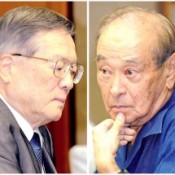
September 12, 2012 Ryukyu Shimpo
On September 11 Defense Minister Satoshi Morimoto met Okinawa Governor Hirokazu Nakaima at the Okinawa Prefectural Office and explained that the emergency landing by an MV-22 Osprey in a field behind a church in Jacksonville, North Carolina on September 6 was caused by an oil leak in the aircraft’s heat exchanger. Morimoto insisted that no safety issues were involved, saying, “If you notice a warning light blinking when you driving, you pull to the side of the road and check your car. It is something along those lines.” Nakaima disagreed, saying, “If a car’s heat exchanger burns out, its engine will stop. This sort of thing should not be understated.”
After meeting Ginowan Mayor Atsushi Sakima, Morimoto talked to the press, saying, “The emergency landing by the MV-22 Osprey in North Carolina could be likened to someone getting off a bicycle and pushing it to avoid the wheels slipping in bad weather.” Morimoto understated the incident by putting the aircraft’s emergency landing on the same level as that of a car or bicycle. Morimoto’s remarks effectively ignored the concerns of the Okinawan people about the safety of the Osprey, which Sakima described as “fear.”
Morimoto explained, “There was a crack in the heat exchanger of the gearbox, where oil leaked. The heat and oil caused smoke.” He went on to say, “It was a preventative landing that does not qualify as an accident.” In response, Nakaima said twice, “You should not understate this incident.”
Nakaima took up a clearly different position to the Japanese government on the explanation of the deployment of the Osprey to Futenma Air Station, saying, “This is unacceptable. I have great difficulty accepting the Japanese government’s explanation.”
Morimoto concluded that the crash of the U.S. Air Force CV-22 Osprey in Florida in June was due mainly to human error. He seeks the understanding of Okinawan people, saying, “The Japan-U.S. Joint Committee is discussing safety issues.”
However, Nakaima said, “When referring to the cause of the Osprey accidents, the
Ministry of Defense differentiates between human error and mechanical malfunction, but that is like saying that the aircraft will crash without any mechanical malfunction, especially when we consider that young marines train at this base.” Nakaima insisted that the government’s explanation does not ease the Okinawan people’s concerns over the safety of the Osprey.
After the meeting, Morimoto talked to the press. When asked about whether safety measures can be applied in the case that an Osprey makes an emergency landing at the base located in a densely populated area where there are no open spaces around the perimeter, Morimoto said, “I cannot answer that question.”
(English translation by T&CT, Mark Ealey)
Go to Japanese
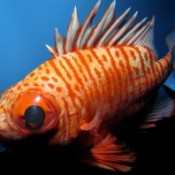
September 9, 2012 Ryukyu Shimpo
From late August, the Okinawa Churaumi Aquarium in Motobu has exhibited the pristigenys meyeri, a rare deep-water fish with distinctive large eyes. The aquarium is putting the fish on display for the first time because it is a species of deep-water fish that is rarely caught.
According to the aquarium, pristigenys meyeri has large eyes and red stripe patterns. It lives at a depth of 100 to 200 meters, and is found in tropical reefs in the Pacific, but it is rarely found.
The fish displayed is about 30 centimeters (12 inches) long. A fishery operator caught it at a depth of 110 meters off the coast of Kume-jima using a single-hook fishing line and brought it to the aquarium.
A staff member at the aquarium commented, “We have wanted to put this species on display but they are difficult to gather information about and to catch. We hope to keep the fish for a long period of time and to research its life.”
(English translation by T&CT, Lima Tokumori and Mark Ealey)
Go to Japanese
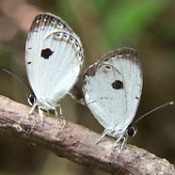
September 6, 2012 Ryota Nakamura of Ryukyu Shimpo
Akino Miyagi, a researcher who belongs to the Butterfly Society of Japan, discovered about 50 pithecops corvus ryukyuensis at the Arakawa River basin in Takae, Higashi. This butterfly has been designated as a near threatened species. The area surrounding Takae is affected by the construction of six helipads that are related to the partial return of the U.S. Northern Training Area.
This butterfly’s numbers are difficult to establish. Joji Otaki, an associate professor of the University of the Ryukyus, commented that the discovery is “very valuable.” Miyagi pointed out that the construction of the helipads and the training for the MV-22 Osprey vertical take-off and landing transport aircraft that is scheduled to take place in Okinawa “might cause ecological damage.”

Red circle: the point of the butterfly's population has been found. Green: the Northern Training Area Circle: existing helipadsTriangle: new helipads
Last October, Miyagi found the pithecops corvus ryukyuensis. This species of butterfly is on the Ministry of the Environment’s red list as a near threatened species and lives only in Iriomote Island and in the northern part of Okinawa known as the Yambaru.
Since she discovered the butterfly there, Miyagi has carried out surveys three or four times a week at Takae. She said that if the construction is carried out and if the Osprey aircraft operate around the area, “the habitat for animals and plants in the forest would be cut in two.” The downdraft from the aircraft may cause “dry areas to spread from one to the next and result in a negative impact on animals and plants. The damage could exceed human expectation.
With regard to the pithecops corvus ryukyuensis, Miyagi said, “Caterpillars are preparing to fly in autumn. We must not destroy the natural environment of the Yambaru.” In the Final Environmental Review that made mention of the environmental impact of the Osprey, the U.S. military admit that among the possible effects on animals and plants that Okinawa rails might abandon their nests. However, there is no mention of insects such as butterflies in the review.
Miyagi said that the U.S. military had conducted an environmental impact assessment in Hawaii and had canceled Osprey training because locals opposed had it. She said, “Takae is in the same situation.”
To protect the rare pithecops corvus ryukyuensis, Miyagi took part in the protest movement against the construction of helipads and raised the issue of the butterfly with the people who oppose the construction.
Environmental disruption threatens the survival of the pithecops corvus ryukyuensis.
Joji Otaki, who is an associate professor of the Faculty of Science at the University of the Ryukyus and a researcher of the pithecops corvus ryukyuensis, commented, “Pithecops corvus ryukyuensis is a precious species of butterfly that lives only on Iriomote Island and in the northern part of Okinawa. In addition, there are very few of them even in that habitat, so a group of these in Takae is very valuable. Because this species of butterfly is found on the forest floor near clear streams they will suffer damage directly if the balance of the natural environment is compromised because of military activities. The destruction of the environment caused by bases and flights may threaten the survival of this precious species of butterfly.
(English translation by T&CT, Lima Tokumori and Mark Ealey)
Go to Japanese
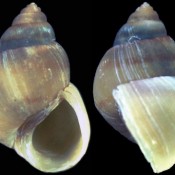
September 1, 2012 Ryukyu Shimpo
On August 28, the Ministry of Environment reported that the Kumejima firefly, which is an endangered and prefectural protected species, has been designated as critically endangered on its revised Red List of Threatened Species. The Miyako kikugashira komori (a small bat, rhinolophus pumilus miyakonis) in the mammal class, the buzzard (buteo buteo oshiroi) in the bird class, and Ryukyu kawazansho (a snail, assiminea sp. D), have been newly designated as extinct.
In the revised Red List, the provisional number of endangered species is now approximately 160, including the Kumejima firefly, and the number of vulnerable species is currently about 180, with the black-naped tern (sterna sumatrana) being added to the list.
Among the eight newly designated extinct species, three existed in Okinawa.
The Natural Conservation Division of Okinawa said, “It is sad that extinct species have been added. Through public lectures, we would like to let people know about the critically endangered species in Okinawa. In 2015 or 2016, we want to publish the revised Red Data Okinawa and request that residents and companies cooperate to limit development of the natural environment.”
In the 1971 survey, ten Miyako kikugashira komori were confirmed as existing, but they were not found in the four surveys held between 1977 in 1996. The buzzard has not been seen since two were confirmed as existing on Kita Daito Island in 1972.
The Ryukyu kawazansho lived on the main island of Okinawa and Yonaguni Island and samples have been collected, but it has not been confirmed that they still exist. Hiroshi Fukuda, a malacologist and associate professor at University of Okayama, said, “They used to be found in places where seawater and fresh water are mixed, such as on Yonaguni Island, in the Naha and Nago areas. They seem to be extinct because of landfill, revetment maintenance, and polluted water drains.”
Fumiyasu Sato from the Kumejima Firefly Museum expressed his concern about the designation of the Kumejima firefly as a critically endangered species. He said, “The firefly can coexist with people. Decreasing numbers of fireflies reflect a crisis in the living environment. This serves as a warning for residents.”
(English translation by T&CT, Megumi Chibana and Mark Ealey)
Go to Japanese
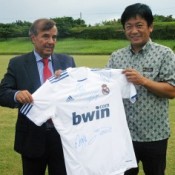
September 1, 2012 Ryukyu Shimpo
On August 31, the Ishigaki Municipal Office announced that the Real Madrid Foundation (RMF) has moved to set up a football academy in Ishigaki. The foundation will be established by Real Madrid, which is a powerful football club in the Spanish first division, and this academy will become the first permanent training school belonging to the club in Japan.
That the same day, RMF academy project manager Manuel Pareno Rodriguez visited the site that it will use as a base, Soccer Park Akanma, and discussed opening the school in November. The academy mainly instructs elementary school pupils, but will consider accepting children of junior high school age or above.
Toshiaki Imai has been appointed as the head coach. He has served as the coach of the Sudanese U-17 and U-20 national teams, the Chinese Taipei national team, the Waseda University team, and the Japanese first division team Kawasaki Frontale. Imai will instruct children with coaches who will be employed.
The RMF has selected Ishigaki as the place to establish the school because a person involved in the RMF lives in Ishigaki, and the island is home to one of the nation’s popular football grounds. Rodriguez said, “There is a wonderful environment here for us. We would like to promote the methods of Real Madrid from here.”
Ishigaki Mayor Yoshitaka Nakayama, said, “I hope that the children of Ishigaki become Real Madrid players in future.”
(English translation by T&CT, Lima Tokumori and Mark Ealey)
Go to Japanese










 Webcam(Kokusai Street)
Webcam(Kokusai Street)


